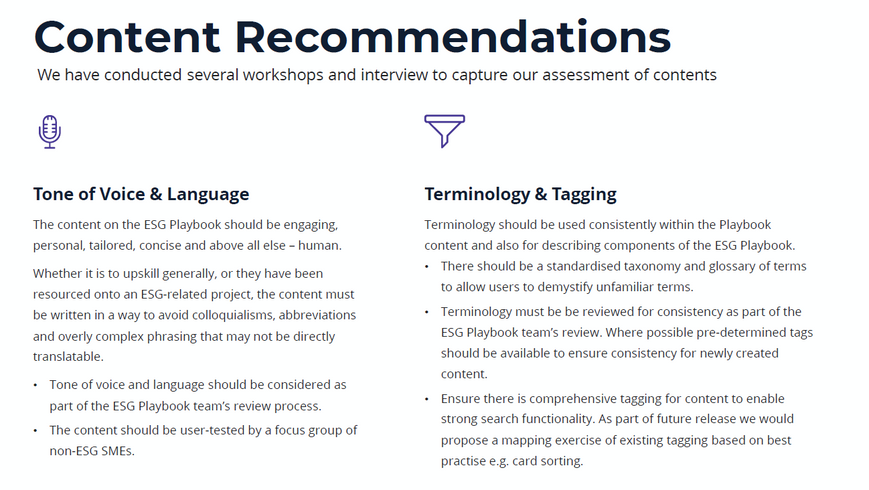ESG Playbook
ESG Playbook 2.0 is an interactive platform that brings together the firm global solutions, insights and tool required by colleagues to understand, sell and deliver ESG services.
Timeline
June 2022
(6 Week)
Team
1 Product manager
2 Product Designers
1 Business Designer
1 Software Engineers
Role
Product Design, Research,
Workshop Facilitator
Problem
There is no central location for the firm employees globally to access ESG-related product services and insight information to enable effective selling, delivering and up-skilling on ESG
Final Outcome
Discovery sprint
Key Insights
The Impact
Through this discovery, we have completed extensive end-user research and technical assessment to validate and prioritise features previously identified, and to form recommendations for a future product roadmap in conjunction with a proposed delivery plan.
Drawing from heuristic assessment, user research, and feasibility evaluation, four pivotal areas for enhancing usability have been pinpointed: advanced search capabilities, improved navigation and information architecture, personalisation features, and enhanced content quality.
The project's impact is evident in the strategic recommendation pack and high-fidelity Figma mock-ups. These resources provide a clear roadmap for improving Version 1 of the product by addressing usability issues, and limitations, and proposing actionable steps. The tangible outcome is a redesigned product that enhances user experience and navigation.
Discovery
Problem definition
We broke down the problem and put it into a concise sentence so that we can make better decisions by putting the users' needs at the center of everything we do. As well as turning a complex problem into a clear and concise sentence which helps to clarify the goal for everyone.
ECO system mapping
In our ecosystem mapping, we've identified key sources within the intranet where users can access ESG information. Additionally, we've pinpointed external websites that users might explore for more comprehensive insights. Understanding the diverse user needs, we've categorized these interactions into specific situations.
Research
Understanding the Vision
To kickstart the session, it is crucial to gather concrete evidence of our users' pain points. understand the vision, guiding principles, and evolution requirements for Playbook 1.0
Defining User Group
Building on our ecosystem mapping, we've identified four distinct user groups within our system. To deepen our understanding of these users, we aim to explore crucial aspects through persona development. Here are the key questions we intend to answer for each group:
-
Content Needs:
-
What type of content is essential for them in the context of ESG information?
-
Which specific details or insights are most relevant to their responsibilities?
-
-
Responsibilities:
-
What are their primary responsibilities within the organisation?
-
How does ESG information factor into their daily tasks and decision-making?
-
-
Day in Their Life:
-
Can we gain insights into a typical day in their professional life?
-
How does the acquisition and utilisation of ESG information fit into their routine?
-
-
Values and Success Metrics:
-
What values do they prioritise in their roles and decision-making processes?
-
How do they define success, particularly concerning ESG-related initiatives?
-
How Might We Session
In our discussions, we employed the "How might we" approach to tackle key pain points, leading to the question: "How might we ensure the solution content is easily digestible, current, and trustworthy?" We then brainstormed creative ideas for content strategies, user interface improvements, and trust-building mechanisms.
Simultaneously, we identified key use-cases and envisioned the necessary features to address them effectively. This approach guides our efforts towards actionable solutions, refining our ideas to better align with the evolving needs of our users.
Feature lists
We reviewed the key features and content requirements discussed in the previous session. We identified "priority features'" for those that would be more difficult to build across most technologies. We then map it back to each user group to see which feature supports their needs.
Personas
Following the identification of distinct user groups, we have crafted three personas to encapsulate diverse perspectives and needs within our ecosystem:
-
Anya the Inquisitive (Explore):
-
A user new to ESG with little or no background in the field.
-
Specific focus on understanding foundational concepts and navigating basic ESG information.
-
-
Jacob the Executor (Sell/Deliver):
-
A sales lead with limited time availability.
-
Prioritizes concise, easily digestible ESG information that aligns with their responsibilities and tight schedule.
-
-
Hina the Promoter (Sell):
-
An individual well-versed and knowledgeable in ESG matters.
-
Find other solutions and their owners, easy-to-access sales materials, and best practices for delivery.
-
Experience Map & Adoption Journey
To gain a holistic understanding of user interactions, we have mapped out the journey for each persona as they engage with the playbook. This journey exploration allowed us to identify key touchpoints and emotional responses at various stages of their interaction.
Additionally, we extended our focus to the adoption journey, aiming to cultivate loyalty to the product. By understanding the user's progression from initial interaction to becoming a loyal user, we identified key milestones and opportunities to foster engagement and long-term commitment.
Heuristic Assessment
I have conducted a heuristic assessment to highlight potential areas for improvement. Based on personas and different use cases, we have assessed the usability of the existing website. We have evaluated the current design across seven usability criteria and identified several areas for improvement
For the "ESG Playbook" we will be using the following heuristic categories:
-
Navigation and IA
-
Efficiency of use
-
Design standards
-
Help and guidance
-
Quality of content
-
Personalisation/Customisation
-
Accessibility
User Interview
User interview Preperation
After defining our personas, we planned user interviews to cover all three types. The interviews aimed to uncover participants' backgrounds, ESG knowledge, and how they access ESG information. We specifically inquired about desired features for the playbook and improvements to the current version.
This targeted approach ensures we gather valuable insights to enhance the playbook's usability and alignment with users' diverse needs.
Pinpoint
Following the interviews, we identified several pain points, I have grouped them into six distinct areas. This categorisation provides a structured framework for addressing and prioritising the identified challenges, enabling targeted and effective solutions to enhance the overall user experience.
We have also collaborated with business designers, who delved into content quality assessment. Through workshops and interviews, they pinpointed two primary issues: tone of voice and language, and inconsistency in content details. Additionally, two minor concerns were identified—terminology usage and tagging, and the inconsistency in graphics and formatting.
Opportunity
In response to user interviews, I have identified six focal areas for improvement: engagement, content quality, connections, ease of use and navigation, integration, and training. These key areas will guide our efforts in refining and enhancing the playbook to better align with user expectations and provide a more comprehensive experience.
Key Usability Improvement Areas
In the redesign phase, our focus was on generating high-fidelity screens for pivotal usability improvement areas. These areas were identified through a combination of heuristic assessment, user research, and a feasibility assessment conducted by our engineering team. The collaborative approach ensures that the redesigned screens are not only visually refined but also strategically aligned with user needs and technical feasibility.
Among the four identified areas, I have worked on the initial three—personalisation, advanced search, as well as navigation and information architecture. Our collaboration with the business designer primarily focused on enhancing content quality.

Personalisation
Enhancing personalisation is essential for tailoring the ESG Playbook to individual user needs. A re-designed landing page, user preferences, dark theme, and notifications contribute to a more personalised and user-centric experience. By acknowledging and accommodating user preferences, we aim to increase user engagement, satisfaction, and overall adoption of the ESG Playbook.
Advance Search
In our focus on advancing search capabilities, three key points have been identified for improvement. Improving advanced search functionalities is pivotal for empowering users to access precise and relevant information efficiently. With enhanced filters, tags, and an intuitive interface, users can navigate the ESG Playbook with ease, saving time and ensuring they find the information they need effectively. This contributes significantly to user satisfaction and overall usability.
Navigation and Information Architecture
We have identified 9 key points to improve navigation & and information architecture. Improving navigation and information architecture is crucial to enhance the overall user experience. Clear pathways, intuitive hierarchy, and consistent labeling reduce user friction, making it easier for individuals to find and engage with relevant content. This streamlined approach not only facilitates efficient navigation but also contributes to increased user satisfaction and adoption of the ESG Playbook.
Content Quality
Business designers recommend the following ways to improve content quality by conducting several workshops and interviews.
Enhancing the quality ensures a consistent and user-friendly experience, aiding understanding and engagement. Standardization and streamlined processes reduce confusion, fostering an environment where users can easily access and comprehend information, ultimately enhancing the effectiveness of the ESG Playbook.
Branding
As a team, we built a style guide to ensure design consistency and scalability throughout the product, and my role focused on working with colours and creating components for our design system.
The primary colours need to work with the dark theme as well as meeting accessibility, complementing the font choice and creating an overall elevated brand personality.
Limitation
We have worked with the developer to identify the technical feasibility. Users have ranked their perceived importance of different features. However, there are limitations to some of the features due to platform restrictions.
-
Research Emerging Technologies:
-
Explore opportunities for integrating AI and machine learning strategies into the ESG playbook to enhance efficiency and effectiveness. Investigate how these technologies can elevate the user experience and contribute to the overall success of the project.
-
-
Usability Testing:
-
Conduct thorough usability testing to validate design decisions and uncover any defects in the redesigned elements. This step is crucial for ensuring that the improvements align with user expectations and contribute positively to usability.
-
-
More Iteration and Testing:
-
Iterate on the design based on the findings from usability testing and user interviews. Conduct additional testing to refine the product's functionality and user experience further. Iterative testing ensures that the ESG playbook evolves in alignment with user feedback and usability standards, fostering continuous improvement.
-
Next steps
Lesson learnt
-
Collaboration is Key:
Collaborating with business designers and other stakeholders proved invaluable. It not only enriched the content quality session but also fostered a holistic understanding of user requirements and business objectives.
-
Iterative Design Process:
Embracing an iterative design process has been crucial. Continuous refinement based on usability testing and user interviews ensures the product evolves organically, addressing real user concerns and aspirations.
-
Technology Exploration:
The exploration of emerging technologies, particularly AI and machine learning, has potential implications for efficiency and effectiveness. Researching and understanding these technologies opens doors for innovative solutions.
-
Usability Testing and User Interviews:
These methods are indispensable for validating design decisions and uncovering hidden user insights. Rigorous testing and interviews not only identify flaws but also provide valuable inputs for future iterations.







































